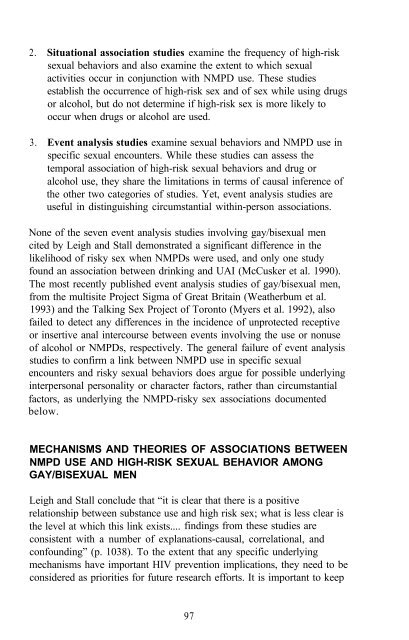The Context of HIV Risk Among Drug Users and Their Sexual Partners
The Context of HIV Risk Among Drug Users and Their Sexual Partners
The Context of HIV Risk Among Drug Users and Their Sexual Partners
You also want an ePaper? Increase the reach of your titles
YUMPU automatically turns print PDFs into web optimized ePapers that Google loves.
2. Situational association studies examine the frequency <strong>of</strong> high-risk<br />
sexual behaviors <strong>and</strong> also examine the extent to which sexual<br />
activities occur in conjunction with NMPD use. <strong>The</strong>se studies<br />
establish the occurrence <strong>of</strong> high-risk sex <strong>and</strong> <strong>of</strong> sex while using drugs<br />
or alcohol, but do not determine if high-risk sex is more likely to<br />
occur when drugs or alcohol are used.<br />
3. Event analysis studies examine sexual behaviors <strong>and</strong> NMPD use in<br />
specific sexual encounters. While these studies can assess the<br />
temporal association <strong>of</strong> high-risk sexual behaviors <strong>and</strong> drug or<br />
alcohol use, they share the limitations in terms <strong>of</strong> causal inference <strong>of</strong><br />
the other two categories <strong>of</strong> studies. Yet, event analysis studies are<br />
useful in distinguishing circumstantial within-person associations.<br />
None <strong>of</strong> the seven event analysis studies involving gay/bisexual men<br />
cited by Leigh <strong>and</strong> Stall demonstrated a significant difference in the<br />
likelihood <strong>of</strong> risky sex when NMPDs were used, <strong>and</strong> only one study<br />
found an association between drinking <strong>and</strong> UAI (McCusker et al. 1990).<br />
<strong>The</strong> most recently published event analysis studies <strong>of</strong> gay/bisexual men,<br />
from the multisite Project Sigma <strong>of</strong> Great Britain (Weatherbum et al.<br />
1993) <strong>and</strong> the Talking Sex Project <strong>of</strong> Toronto (Myers et al. 1992), also<br />
failed to detect any differences in the incidence <strong>of</strong> unprotected receptive<br />
or insertive anal intercourse between events involving the use or nonuse<br />
<strong>of</strong> alcohol or NMPDs, respectively. <strong>The</strong> general failure <strong>of</strong> event analysis<br />
studies to confirm a link between NMPD use in specific sexual<br />
encounters <strong>and</strong> risky sexual behaviors does argue for possible underlying<br />
interpersonal personality or character factors, rather than circumstantial<br />
factors, as underlying the NMPD-risky sex associations documented<br />
below.<br />
MECHANISMS AND THEORIES OF ASSOCIATIONS BETWEEN<br />
NMPD USE AND HIGH-RISK SEXUAL BEHAVIOR AMONG<br />
GAY/BISEXUAL MEN<br />
Leigh <strong>and</strong> Stall conclude that “it is clear that there is a positive<br />
relationship between substance use <strong>and</strong> high risk sex; what is less clear is<br />
the level at which this link exists.... findings from these studies are<br />
consistent with a number <strong>of</strong> explanations-causal, correlational, <strong>and</strong><br />
confounding” (p. 1038). To the extent that any specific underlying<br />
mechanisms have important <strong>HIV</strong> prevention implications, they need to be<br />
considered as priorities for future research efforts. It is important to keep<br />
97
















